Rosie The Riveter
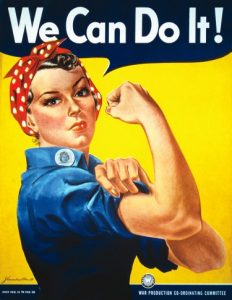
Rosie the Riveter was a iconic image, created in 1940 and was used during World War II to inspire women to join the war effort and to take over the factory jobs that men had been working. As the fighting continued the working aged men were being called to fight and protect the country. She became a symbol of womanhood throughout this time period. Her iconic “we can do it” became a cry for women to step out of the social norms that they had been accustomed to and help the US beat the Central Powers. During the 40’s the pay gap between women and men was vast so as the men were leaving their jobs the companies were able to fill them with workers that were willing to be payed much less then the men. This poster is one of many that were used throughout the Second World War and beyond to sway the public to the governments point of view.
Women in the War: We Can’t Win without Them
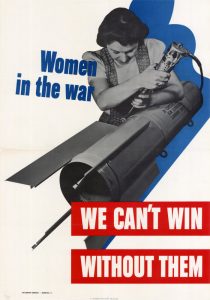
This poster was created in 1942 by the US government in order to inspire women to work outside of the ordinary sphere of household or textile work and move into heavy lifting factory jobs that would have only been done by men before war times. However as more men were needed to fight the only people left in the factories was women so the government needed them more than ever in order to build plane and other heavy duty equipment that was needed to win the war. As the fighting continued these women were able to make a huge impact on the work being done. It shows that during this time even though women were not actually fighting in combat they were necessary for the war effort and the outcome could have been very different without them. By showing different jobs that women are able to accomplish to the public it is meant to inspire and influence women to show them what is possible, and how they do not have to be limited by the social structures set around them.
Do the Job He Left Behind
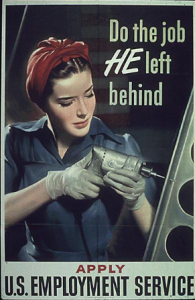
This poster was made in 1942 in order to persuade young women into getting a job. This poster depicts a woman working with large heavy metals and states that women should take over where their men left off. This poster was part of a much larger campaign that spreads throughout the course of the war in order to show women what they could do if they changed their lifestyle. This kind of poster was used by the government in order to make sure that while they were taking all the well bodied men for fighting that the United States industries would not collapse. This idea of women working for themselves leads into later feminist ideals that inspire women to work and think for themselves.
Release 6
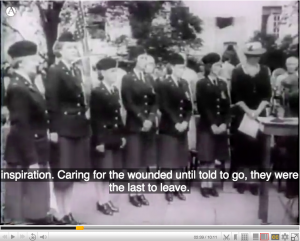
link to full video: https://envoy.dickinson.edu:6328/view/work/bibliographic_entity%7Cvideo_work%7C1786108
This is a clip from 1942 showing women not only working in factories and lumber yards, but also working for the military testing the weapons that are going to be sent overseas to the men fighting. These women shown being used to show the public all of the opportunities that women are using in order to do their part in fight without actually being on the front lines. This video also shows a clip of women getting recognized as nurses for the vital roles that they played in getting american soldiers home safely. The women who worked in the different war jobs for the government shows the beginning of the Women’s Army Corp that allows women a greater role in the armed forces.
Release 105
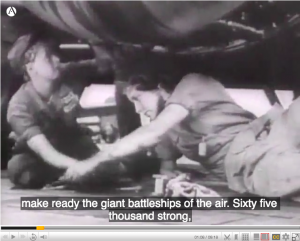
Link to full video:https://envoy.dickinson.edu:6328/view/work/bibliographic_entity%7Cvideo_work%7C1786094
This video was created in 1944 by the United Newsreel Corporation in order to show the public that women can hold higher jobs in the military and making a lasting effect on the effort against the allied powers. This video primarily focuses on the Women’s army Corps or the WACs. These women work for the military to build aircrafts and other wartime equipment needed. Some of these women were even leaving their homes and going across the ocean in order to repair and work as an active part in the war effort. Many young women were getting jobs in order to sustain themselves while the men in their families were off fighting. These women were the start of popularizing women becoming a larger part in the victory in the Second World War.
Longing Won’t Bring Him Back Sooner . . . Get a War Job!
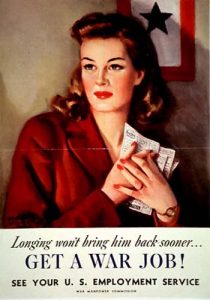
This image was made in 1944 in order to get women to take jobs that are left vacant by men who have gone off to fight. This poster shows a woman holding letters waiting for a man to come home to her with a longing look in her eyes. While the caption is saying that doing nothing and just waiting for him to come home is just a waste of time and she should be doing something more productive like getting a job. At this point in WWII the US had been involved in the fight for about 3 years and some women just wanted their husbands back, however they couldn’t until the war won. This source is a later poster made that is trying harder to convince women that they should work because they have nothing better to do, while the earlier campaign posters worked to inspire women to want to help their country.
Interview by James H.R. Cromwell and William Bradford Huie Chronoscope, Helen Hayes
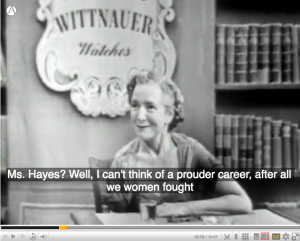
link to full video: https://envoy.dickinson.edu:6328/view/work/bibliographic_entity%7Cvideo_work%7C1789505
This video was recorded in 1951 and depicts Helen Hayes talking about the need for more women to join the armed forces. A new opportunity for women was forming as the option to go into the armed forces was becoming an actual career choice that was available to them. This was important, because as the war was ending many people thought that women would just go back to the home spheres that they were in before the war, however Hayes is trying to convince the public that women are still needed in these jobs and they are much better for them then a business or working in the private sector. These jobs were considered to be much more equal and came with better benefits than what was normally available for young women. This carried on until the time that the cult of domesticity was becoming popular in their attempts to put women back into household jobs.
